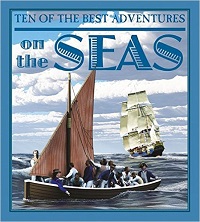| ________________
CM . . .
. Volume XXII Number 29. . . .April 1, 2016
excerpt:
Each of the explorers’ “adventures” is described in approximately 200 to 250 words. One paragraph before and after each adventure uses another approximately 100 words to first set the scene and then provide an epilogue. A glossary is included at the end of the book for the words in bold. Each story is accompanied by an excellent, realistic, full-page, colour illustration, a portrait of the explorer, and a small map showing his route. The “adventures” begin with Bjarni Herjólfsson, the ‘Reluctant [Norse] Explorer’ who, in 986 CE, unwittingly became the first European ever to discover North America on his way from Iceland to Greenland. “Shipwrecked”, the next adventure, tells how, in 1492, Christopher Columbus discovered some Caribbean Islands believing they were the East Indies, and “late at night on December 24, disaster struck. Columbus’s ship, Santa Maria, struck a coral reef.” “Around the World” tells the story of Ferdinand Magellan in the above excerpt. “Explorer Pirate” covers Sir Francis Drake’s problems with the Spanish and his two circumnavigations of the globe. “Cast Adrift” tells of Henry Hudson, his search in (the now) Hudson Bay for a passage to the Pacific, and his mutinous crew. “Bucaneer Explorer” touches on William Dampier’s lifelong love of the sea. He was the first Englishman to travel around the world three times and map parts of Australia and New Guinea. Two sentences are devoted to his adventure across part of the Indian Ocean with eight other men in a canoe to which he’d added outriggers and a sail. “Captain Cook” tells what happened to the British explorer after he became the first European to make contact with the Hawaiian people. It was in Hawaii that – ultimately due to his lack of understanding of the culture – Cook lost his life. The following three “adventures”, the best of the bunch, give readers at least a bit of a sense of character of the explorer involved, and, therefore, someone to almost care about, which every story – no matter how brief – needs. “Mutiny” sketches the story of the months Captain Bligh’s crew spent in Tahiti, Bligh’s indignation with their behaviour, and the aftermath of the crew’s mutiny. “Marooned” tells of Alexander Selkirk who, foreseeing the demise of the ship he was on, chose to be marooned on an island off the shores of Chile, yet never expected to be left on the island for five years. “Kon-Tiki” tells of Thor Heyerdahl’s 1947 expedition from Peru to French Polynesia on a raft made of balsa logs in an attempt to prove his theory that the islands in the South Pacific Ocean had been first settled by Peru’s early civilizations. Most of the stories will inspire questions in interested and curious young readers. For instance, of Magellan’s 150-man crew, if only 49 died with Magellan, why did only 18 return to Spain? Or, why would Magellan attack a native who refused to convert to Christianity? Or, why would Henry Hudson spend so much time in Hudson Bay? So, if keen young readers of Ten of the Best Adventures on the Seas have someone able to continue a discussion with them about these stories, they could lead to some interesting insights into history, human nature, geography, and more. However, in approximately 300 words, these “adventures” include little more than the bare facts – dates, names, places – which are good for a school assignment of some sort, but will likely leave the average young reader uninspired, if not confused. Not Recommended.
Karen Rankin is a Toronto, ON, teacher and writer of children’s stories.
To comment on this title or this review, send mail to cm@umanitoba.ca.
Copyright © the Manitoba Library Association. Reproduction for personal use is permitted only if this copyright notice is maintained. Any
other reproduction is prohibited without permission.
CM Home |
Next Review |
(Table of Contents for This Issue - April 1, 2016.)
| Back Issues | Search | CM Archive
| Profiles Archive |
